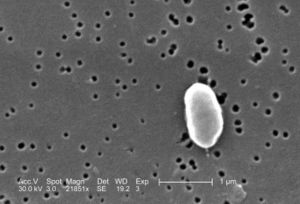Vibrio parahaemolyticus: Difference between revisions
| Line 91: | Line 91: | ||
==References== | ==References== | ||
[http://www.cdc.gov/ncidod/dbmd/diseaseinfo/vibrioparahaemolyticus_g.htm "Disease Listing, ''Vibrio parahaemolyticus'', General Info". Centers for Disease Control and Prevention. October 25, 2005.] | [http://www.cdc.gov/ncidod/dbmd/diseaseinfo/vibrioparahaemolyticus_g.htm "Disease Listing, ''Vibrio parahaemolyticus'', General Info". Centers for Disease Control and Prevention. October 25, 2005.] | ||
<br> | <br> | ||
Revision as of 06:47, 3 May 2007
A Microbial Biorealm page on the genus Vibrio parahaemolyticus
Classification

Higher order taxa
Bacteria (domain); Proteobacteria (phylum); Gammaproteobacteria (class); Vibrionales (order); Vibrionaceae (family); Vibrio (genus); Vibrio parahaemolyticus (species)
Species
|
NCBI: Taxonomy |
Vibrio parahaemolyticus
Description and significance
Vibrio parahaemolyticus is a gram negative bacterium that is typically found in warm estuarine seawaters due to its halophilic (salt-requiring) characteristics. It is the number one leading cause of sea-food associated bacterial gastroenteritis in the United States.
V. parahaemolyticus causes diarrhea upon ingestion. While the overwhelming majority of people acquire the infection by eating raw or undercooked seafood (particularly shellfish and oysters), an open wound exposed to warm seawater can facilitate V. parahaemolyticus infection.
Isolation of V. parahaemolyticus is possible from cultures of stool, wound, or blood. Isolation from stool preferably involves a medium that contains thiosulfate, citrate, bile salts, and sucrose (TCBS agar).
Genome structure
Shotgun sequencing of Vibrio parahaemolyticus AQ3810 is unfinished. To this date, 2 plasmids (pO3K6 and pSA19) and 2 chromosomes (chromosome I and chromosome II) are completely sequenced. The importance of plasmids to the organism's lifestyle is unknown at this point.
Vibrio parahaemolyticus AQ3810 (unfinished)
DNA structure: other
Length: 5,771,228 nt
Replicon Type: chromosome
Created: 2007/01/11
Vibrio parahaemolyticus plasmid pO3K6, complete sequence
DNA structure: circular
Length: 8,784 nt
Replicon Type: plasmid
Replicon Name: pO3K6
Created: 2000/06/29
Vibrio parahaemolyticus plasmid pSA19, complete sequence
DNA structure: circular
Length: 4,839 nt
Replicon Type: plasmid
Replicon Name: pSA19
Created: 1996/05/23
Vibrio parahaemolyticus RIMD 2210633 chromosome II, complete sequence
DNA structure: circular
Length: 1,877,212 nt
Replicon Type: chromosome
Replicon Name: II
Created: 2003/03/10
Vibrio parahaemolyticus RIMD 2210633 chromosome I, complete sequence
DNA structure: circular
Length: 3,288,558 nt
Replicon Type: chromosome
Replicon Name: I
Created: 2003/03/10
Cell structure and metabolism
Describe any interesting features and/or cell structures; how it gains energy; what important molecules it produces.
Ecology
Describe any interactions with other organisms (included eukaryotes), contributions to the environment, effect on environment, etc.
Pathology
How does this organism cause disease? Human, animal, plant hosts? Virulence factors, as well as patient symptoms.
Human ingestion of V. parahaemolyticus causes various symptoms, including diarrhea, abdominal cramps, nausea, vomiting, headache, fever, and chills.
Application to Biotechnology
Does this organism produce any useful compounds or enzymes? What are they and how are they used?
Current Research
Enter summaries of the most recent research here--at least three required
References
CDC Public Health Image Library
Edited by Hau-Chen Lee, student of Rachel Larsen and Kit Pogliano
